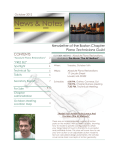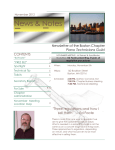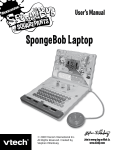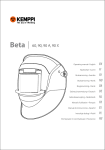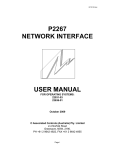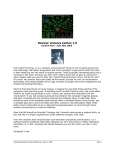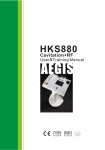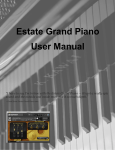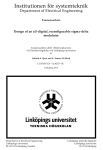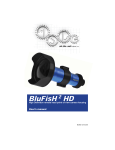Download March 2012 - Boston PTG Chapter Website
Transcript
March 2012 News & Notes Newsletter of the Boston Chapter Piano Technicians Guild CONTENTS Jim Ialeggio 2 “PREZ SEZ” Member Spotlight 3 March MEETING - Grand Piano Solutions FEATURING: Jim Ialeggio 4-5 When: Tuesday, March 13th Technical Tip 6 Where: Tidbits 7 41 Parker Rd, Shirley, MA 01464 Secretary Report 8 Schedule: Events Calendar 8 6:00 PM. Gather, Converse, Eat 7:00 PM. Chapter Business Meeting 7:30 PM. Visit with Jim Ialeggio For Sale 9-11 12 March Meeting Location Map 12 Jim Ialeggio Insight into Steinway Tubular action rail problems. Inconsistencies and inaccuracies either from the factory or due to aging can make locating action centers consistently and accurately time consuming or impossible. Learn how to “prove” whether a S&S tubular action will allow you to regulate consistent action. TOPIC: Chapter Administration Grand Piano Solutions - Steinway Tubular Action Rail Problems…(or, how to measure almost anything) In a “passing of the baton” ritual, for the past two years, John Dewey, the “go to” guy for Steinway action frame repairs for over 30 years, has been mentoring Jim Ialeggio to continue his S&S action frame work. Jim has expanded on John’s ideas and created the next generation of precise S&S action rail soldering and positioning jigs. March 2012 News & Notes Page 2 This technical is a preview of a class Jim Ialeggio will be presenting in April at NEECSO 2012. S&S actions have a reputation for inconsistent action geometry, and the inconsistencies can seem to be random. When inconsistencies in an S&S action thwart your best attempts at regulation, stop…take two steps back. Significant inconsistencies often originate in the challenging S&S tubular rail system. The inconsistencies sometimes develop over time, as with split and twisting rails, but sometimes the inaccuracies were soldered into the frame right at the factory. The bottom line is, poorly positioned tubular rails can make locating action centers consistently and accurately extremely time consuming or impossible. Learn why S&S rails are so tricky in relation to other action frame systems, and learn how to “prove” whether an S&S tubular action frame will allow you to regulate a consistent action. A second part of the technical will be presented at NEECSO 2012. It will cover how to avoid the pitfalls of misleading, inaccurate measurements, and as a bonus learn how to measure just about anything. From His Website: www.grandpianosolutions.com Your piano can sing. Your piano’s tone and touch can be shaped and sculpted… every part of your piano, even its sound, can be customized. I customize pianos. How do you create a piano that is an absolute joy to play?… How do you create your ideal piano? Think of creating your ideal piano as a collaborative process of discovery and refinement. In this process, I help the pianist to discover what sounds their piano has the potential to produce. Then I refine the piano until it has achieved that potential. Since the piano only reveals itself slowly, the process is somewhat circular… with each new improvement, new possibilities arise. The pianist’s informed input is essential to the success of this process, so as a piano restoration specialist and teacher I help pianists acquire the information they need to discover possibilities and make informed and inspired choices for their piano. Demystify Your Piano Tone and Touch follow. They are designed to help you ask the questions that will reveal your piano’s possibilities. Piano Services can help you target which of my technical services would allow us to create your ideal piano together. March 2012 News & Notes “PREZ SEZ” Page 3 Doug Tybor, RPT President, Boston Chapter PTG Hello Everyone – The 2012 NEECSO Seminar is upon us, and in case you haven’t heard, registration is now open. Go to www.neecso-ptg.org where you can print & mail a form, or register online. April 2 is the deadline for submitting names of delegates and alternates for the 2012 PTG Council Book mailing, so we need to confirm who will represent the chapter in Council on July 9 and 10 in Bellevue, WA. We are also at the time of year when nominations for chapter officers are considered. If anyone has a desire to run for the position of a chapter officer, please let me know. And now, a digression.... Wines and whines. Call it two extremes in the world of piano tuning customers....Many years ago I tuned a new studio-type upright piano for a customer that I had serviced once before. This was the piano’s second tuning since he bought it, but the first time he was at home while I went to work. Everything went alright throughout the tuning; it behaved as I expected, and it sounded consistent with every other piano of this brand and style that I tuned. But...funny thing about a few new piano owners. Perhaps it’s buyer’s remorse, unrealistic expectations....perhaps he was hearing different things with the front panels removed, or hearing things not heard in his former piano. He was hearing the reverberation that happens after the dampers damp the strings. He persisted in complaining that the reverberation wasn’t there before. Bottom line - in the customer’s eyes (and ears), I damaged, possibly ruined the piano. And nothing, nothing I could say or explain was sufficient to move this person from his perspective that his was the only point that mattered, and that I caused this effect. It was done. Just one anecdote in this tuner’s life. Fast forward twenty years.... I was on my way to a new customer’s home to tune their piano for the first time, running late to this last appointment of the day because of the blizzard of March 1, 2012. He called, and I assured him I wanted to keep the appointment, and would be along shortly. After arriving, and as I was setting up the piano for tuning, he came into the room and gave me a bottle of red, and thanked me for fulfilling the appointment, as he were really excited to be playing his new grand piano. We meet all kinds of people in this craft that we love, and I have heard many stories from fellow technicians about people and pianos. Some doors close, some doors open. Share your story sometime. Ultimately, I hope your wines far exceed your whines. News & Notes March 2012 Member Spotlight Page 4 Jim Iaeggio With a BA in Music Composition, that is, a degree in high art, I started my career teaching Junior High General music in a war zone on Long Island. A trial by fire it was too, being hired after the previous teacher packed up mid-year, and left for good without a word. The principal wanted to rehire me at the end of that year. He called me into his office and said I was great. I said…”obviously you’ve never properly witnessed the shear mayhem in my classroom.” His reply, “Hey, you’re still here, that’s amazing!” His competence threshold was a bit lower than I had expected. Anyway, goodbye to Long Island and off the Nantucket High School for 2 yrs of teaching rednecks how to sing. I wasn’t happy teaching, as there was precious little interesting music that came with the gig, and interesting music was what I was looking to make. So I packed off to Boston, ostensibly to sing in the early music scene, but also to try to figure out what it was I wanted to do, since I wasn’t clear on that point. Music was an important part of my life, but what does one do to earn a living with music, especially if performing is not your favorite trick? Thinking about it, I’d realized I had gone to college, then into teaching, just following the prescriptions and examples laid down for me, but I had no clue what I was doing or what I wanted to do. I decided I wouldn’t do anything until I had some inkling of what I wanted to do. So there I was not doing much of anything, just being a poor, very semi-employed singer, living off my teaching savings. To pass the time, I started to reconstruct an antique cider press, the cast iron parts of which I had picked up, on a whim, at auction for 3 bucks. As far as I can remember, my only carpentry tools at the time were a vise-grip and a toothbrush (not sure what I did with the toothbrush). I’d spend huge amounts of time picking the local hardware store guy’s brain, and then buy a nut and washer for the princely sum of 10 cents to compensate him for his mentorship. I borrowed a circular saw and router table, got some pine and fir, chatted up the bicycle parts guy and got some cycle gears for the grinder, jury rigged a stone age lathe for the grinder barrel…low tech, man. Slowly, it came together, and so did the realization that I liked to solve mechanical problems, and I liked wood, liked working the wood and enjoyed using the tools (meager as they were). My grandparents were artisans, and unwittingly I had bucked the immigrant family, upwardly mobile trajectory to re-enter the land of the laborer. I started as a carpenter doing small home remodels, some larger remodels, historic restorations, then designed and built a number of houses, including our home and shop in Shirley. In this work, I was always drawn to the windows, particularly in historic work, as the sash defined the building’s aesthetic personality. I began trying to reconstruct the obsolete skill sets needed to replicate these windows, learning by mistakes, dissecting old March 2012 News & Notes Page 5 Member Spotlight continued sash, and chatting with a small group of like minded sash makers. With the historic sash and windows, I found that my love of mechanical puzzles, woodworking, joinery, and design could be combined in a way that satisfied my need to include aesthetics in my work life. I did this for 15 years in projects throughout New England. Between the sash making and family responsibilities, my music fell into the background, and became mostly silent…I missed it sorely, but didn’t know how to allow it to be more present in my life and work life. Enter (stage left), my tired, abused, poorly tuned console. This beast reflected the low position music had occupied in my life for a while. Happily, I started composing and improvising again, and serendipitously this screaming console was my instrument. In preparation to make a CD, playing that console, I recorded some pieces to help critique the compositions. As I listened to the recordings, I was struck by how unmusical the sound of that console was. I thought about it and tried to figure out what I might be doing that made that piano sound so unpleasant, and I realized that this piano just sounded in and of itself awful. I was floored by the disconnect between the piano sound that I had constructed in my head, and the sound which was actually being produced by that piano. This disconnect, the gulf between the imagined and the actual piano sound, is what pushed me into the world piano technology. I began wondering if other pianos sounded as unmusical as that one. So I started listening around, and what I found, or rather didn’t find inspired me to take the skills I had developed in years of picky woodworking, mechanical problem solving and design, and use them to try to create the piano sound my composer’s ear wanted to hear. Rebuilding pianos, that is, designing and building structures that are capable of creating beautiful piano tone, is my main interest in piano technology. Though at first I was not terribly interested in the tuning aspect of the work, when I realized how central the tuning and prep was to creating the sound I was seeking, the tuning hit with a passion too, and is coming along nicely (though it was a struggle at first …sound familiar?). Regulation and tone development are revealing themselves to be something I have an intuitive knack for, though the intuition is informed by the time I spend experimenting with piano sound in the shop. I’m still living a life of relative penury, but now as a piano technician and rebuilder. The musician is once again active, teaching the artisan, skilled woodworker, and engineer how to create really nice sounding pianos. March 2012 News & Notes Page 6 TECHNICAL TIP “Chinglish, White Noise & The Tunnel” It is 5:15 am and since I did not get any tech tips I decided to write about a tuning last night rather than reformat the newsletter which would take just as long. Last night I showed up at a clients home @ 5:30pm to tune his Baldwin upright. I set my tool box down, spoke a bit with the customer, and got my kid situated on the couch. After removing stuff from the top of the piano and the various parts I went to it, explaining to the customer it would need a pitch raise and more money. After getting almost through the temperament I remembered my kid had a lesson on simple and complex machines so I proceed to ask him questions regarding the tuning lever, and the re-stringing lever which had fallen out of the stupid case as it always does when I open it. He replied “the tuning lever is a simple machine and the restringing lever is complex”. His explanation was that the restringing lever had a wheel, axle and lever which made it complex vs. the tuning lever which is a simple machine. -seemed correct to me by the definitions he was given on the work sheet. Temperament done, moving into the low notes, talking to the customer a bit about what he likes to play. Not real talkative, which is good, it is late and I want to get out of here. I begin to notice that the room acoustics are live and the reverb/echo is rather pronounced which will make the high end a joy. It is now about 20 minutes later, my kid is reading and asking me how is it going? I respond “good almost done with the high end and I will be going through the piano again”. He gives an “ohh” with the kind of inflection in his voice of resigned disappointment. Starting the fine tuning again I realized that the piano dropped a bit more in pitch than expected. I had started it sharp enough to have it fall in right @440A but then again, that is never a sure thing. So I decide after hitting a few octaves up and down that it would be just as easy to put it at 440A rather than leave it slightly flat. By now A female shows up at the door, and the client goes to answer. He begins a long conversation in Chinese with sporadic English words. They are in a hallway, which runs the length of the house. The piano sits on the wall which runs the length of the house. I immediately realize why the reverb / echo has been so problematic, the hallway is acting like a big echo chamber, and the piano is optimized for taking full advantage of this. I have been making all adjustments on each note much “earlier” than I typically do subconsciously. -Now I know why. 10 minutes into their conversation, I begin to feel like I am listening to an Opera, they are speaking with much passion, and volume. My mind begins to wonder if I should reinstitute the old practice from 15 years ago asking for them to well “shut up”. However, as the annoyance of trying to hear what I am doing over that my mind starts to hear the white noise of the computer fans behind me even louder. I remember all the big band tunings I would do in the Hudson Valley before most of the places went out of business, and on the concert series I promoted. I quickly realize that I tried that technique then and you get one player to cooperate and the next comes in and plays while the other who stopped playing his instrument proceeds to fumble with his case. -Click, bang Flump ...erckkk...I gave up on this technique years ago. My annoyance grows as I irrationally consider telling the customer to move the piano so it is not subject to the hallway and its effects. Then I got a grip on my mind and went back to my practice as of the past 15 years and started to just ignore the opera in the hallway, the fan from the computer, the never ending lateness of the notes coming back down the hallway the annoyance of the tapping of my kid knocking his foot against the floor out of time with the beating of my key blows. I relax and say to myself, “it does not really matter it is just a piano and some noise. There are only a few things to listen for and if I just relax, I will hear them, or at least hear the space the sounds are supposed to be in which also works”. Tuning is done I check up and down, find a few notes I don’t like and fix them, put my tools away, and the customer asks me for payment info. I try to add the figures of the pitch raise and tuning and give him a figure, my mind seems to not think it is correct, however my kid being on the math these days says “daddy you are right that is correct” Getting in the car, I say to my son “Dawson, did they seem loud to you”. He says “yes Daddy, they were talking so loud in Chinglish, I could hardly concentrate on my book.” Then he burst into a story and a bunch of questions, my mind really wanted to shut down at this point but os stayed focused on the conversation. Bill Trotman News & Notes March 2012 Page 7 TIDBITS ASSIST WITH THE TUNING EXAM—We have been doing quite a few tuning exams lately. Any RPTs out there willing to help out? The tuning exam requires one CTE (Certified Tuning Exam-iner) and two (or more) RPTs. Recently I asked several RPTs to help out and both were under the mistaken impression that one had to be a CTE to take part in a tuning exam. Not so. Any RPT can help. It’s a good way to give back to our organization, have fun and probably learn something. Plus you have the satisfaction of knowing you are helping uphold the high standards of PTG! There is no monetary reward, but you might get a sandwich and cup of coffee, and reimbursement for parking. Another reminder—the pool of CTEs nationwide is shrinking. If any RPT is considering becom-ing a CTE, the first step is to take the full tuning exam (entirely by ear) and pass all catego-ries at 90 or above. THE TEST FEE IS WAIVED, whether or not your scores are all 90 or above. The Boston Chapter does testing on a by request basis. So, if anyone is thinking about tak-ing the tuning exam, it usually takes a few weeks to set up a time. Testing is done at North Bennet St. School on one of three approved pianos: A Steinway L, a Mason & Hamlin BB or a Kawai RX2. Questions? Call or email me. - Christine Lovgren Spongebob, your not a piano tuner! You would not know musical talent if it hit you right in the forhead! Cuahh, cuahhh, cuahhh thinking you guys could tune the piano of a world class clarinetist. A RECENT BLOG POST FOUND ONLINE: Duaaa, spongebob can’t we go jellyfishing? Hey Patrick, try this hammer B. Trotman March 2012 News & Notes Page 8 Secretary Report Eric Donnelly Joe Morocco presented the Treasurer’s Report. Doug Tybor mentioned that the website has been updated to include two new links on the home page, including a direct link to the Boston Chapter member directory, and a link to the National PTG zip code RPT search. He also presented a proposal from Gary Van Dine for a complete redesign of the website as a database-driven website. The estimate was $1300-$1400. The matter was discussed but no motion was made. NEECSO registration for April 26-29 in Burlington, VT is currently underway. The rooms are approximately $135 per night. As for NEECSO 2014, so far Tom Driscoll has volunteered to be in charge or organizing instructors, and Bill Trotman has volunteered to help facilitate moving services. Both the Marriot in Burlington and the Hilton in Dedham seem to be good contenders for a host facility according to the research done by Doug Tybor. New members to the chapter include David Moulton, Mark Whitlock, Liao Liu, and Scott Ness. Jim Ialeggio brought up a suggestion to consider having Bill Bremmer come to do an all-day tuning class for the chapter sometime next year. Topics would include the ergonomics of tuning, EBVT III, as well as others. David Stanwood’s presentation focused on hammers and some of the most extreme things you could do to a hammer. He talked about the compass needle and ball peen hammer technique he demonstrated last year. He also covered the tonal effect of using binder clips on a hammer shank, and passed around different hammer felts including some removed from the molding. Finally, he demonstrated what the piano would sound like with the following items in place of hammer felt in an actual “prepared” hammer: a wine cork, a pool cue tip, a key lead, and a plastic pipe. Thanks to David Stanwood for presenting, Debbie Cyr and Brandeis for hosting, and as always, Chefmaster Flash Ewing. EVENTS CALENDAR March 13th Jim Ialeggio’s Shop Shirley, MA April 2 April 2 April 26th - 29 NEECSO Seminar Burlington, VT www.neecso-ptg.org PTGF scholarship applications due to Home Office May 14 DAVID KIRKLAND from Steinway, talking about his Delegate names an Council new book The Official Guide reports due: [email protected] to Steinway Pianos March 2012 News & Notes Page 9 FOR SALE Currently restoring 3 Steinway model M 5’7" grand pianos, 2 in mahogany cabinets, 1 satin ebony. Let me know if you have interest in any of these pianos. I now have access to a large number of un-restored Steinway and Mason & Hamlin grand pianos, so if there is a particular model size or cabinet style you are looking for, let me know. I always have a selection of Yamaha and Kawai upright and grand pianos and some smaller console pianos. If you are searching for a particular piano in a specific style or size, please let me know. I can often search out just the piano for you. Martin Snow 781-837-6531 [email protected] 1985 Yamaha G2, 5’8". The perfect grand piano for the home. This piano retails new for over $35K. At Martin Snow Pianos, my NEARLY NEW price of $11,900 includes delivery, 5 year warranty and first in-home piano tuning. I have a Zuckerman harpsichord built from a kit 30 years ago, and not used for more than five years. It is in good shape, needs some string replacements. I will part with it for a contribution to a non-profit. It is valued at $600. This instrument is a real harpsichord; it also is a great teaching tool for learning about tuning and shaping plectras which pluck the strings. I built this with my young daughter, who later moved away to college, and on. Center Harbor NH (603) 253-4342 Kent Kawai RX-3 Professional Piano purchased new in Feb of 2000 from a large Kawai dealer in Boston. This piano is in excellent condition, near mint and has been tuned regularly. It’s 6-feet 1-inches long and classified as a Grand Piano, not a “Baby Grand.” Its has the sound necessary for a professional concert or for a recording artist. If your shopping for ahigh-end piano research this model, its one of the best for talented players, students and professionals. Before purchasing this we studied the famous green Piano book which has rated the Kawai pianos one of the best in the world because of its sound, quality and craftsmanship. I just had this piano tuned, so it sounds beautiful. Additional pictures available upon request. Located in Salem MA - $13,500.00. If your interested, email me to set up an appointment to come by and play it: [email protected] For Sale: Samick Grand Piano with working, fully functional Pianocorder P100 player system. Piano model is G-1A (5' 1"), serial number 820225 (30 years old), walnut polish finish. Original owner, properly tuned and maintained. Bench is included. Also included are Pianocorder user manual and 22 tapes. Can also provide contact information for service professionals familiar with Pianocorder systems. Additional photos available upon request. $5500. Located in Beverly, MA. Doug Tybor: [email protected] or 617-6453519. 1234567890123456789012345678901212345678901234567890123456789 1234567890123456789012345678901212345678901234567890123456789 1234567890123456789012345678901212345678901234567890123456789 March 2012 5'2" Knabe grand News & Notes Page 10 1234567890123456789012345678901212345678901234567890123456789 1234567890123456789012345678901212345678901234567890123456789 1234567890123456789012345678901212345678901234567890123456789 1234567890123456789012345678901212345678901234567890123456789 I have a customer who 1234567890123456789012345678901212345678901234567890123456789 1234567890123456789012345678901212345678901234567890123456789 1234567890123456789012345678901212345678901234567890123456789 must sell his 5'2" Knabe 1234567890123456789012345678901212345678901234567890123456789 1234567890123456789012345678901212345678901234567890123456789 grand by the end of this 1234567890123456789012345678901212345678901234567890123456789 1234567890123456789012345678901212345678901234567890123456789 FOR SALE month (August). It is in very 1234567890123456789012345678901212345678901234567890123456789 1234567890123456789012345678901212345678901234567890123456789 1234567890123456789012345678901212345678901234567890123456789 good shape for original (Cont.) 12345678901234567890123456789 1234567890123456789012345678901212345678901234567890123456789 12345678901234567890123456789 1234567890123456789012345678901212345678901234567890123456789 parts (I replaced an 12345678901234567890123456789 1234567890123456789012345678901212345678901234567890123456789 12345678901234567890123456789 1234567890123456789012345678901212345678901234567890123456789 Bill Fucito at 978-692-3293 agraffe, the two strings 12345678901234567890123456789 1234567890123456789012345678901212345678901234567890123456789 12345678901234567890123456789 1234567890123456789012345678901212345678901234567890123456789 that went through it and (Westford, MA). 12345678901234567890123456789 1234567890123456789012345678901212345678901234567890123456789 12345678901234567890123456789 1234567890123456789012345678901212345678901234567890123456789 12345678901234567890123456789 1234567890123456789012345678901212345678901234567890123456789 one hammer head). He Barry Rosenberg, RPT 1234567890123456789012345678901212345678901234567890123456789 12345678901234567890123456789 12345678901234567890123456789 1234567890123456789012345678901212345678901234567890123456789 wants $4000 or best offer. The Gordon College Department of Music receives an annual loan of new Kawai pianos for our education, practice, and performance needs. These pianos are provided at no charge to us. Having these quality pianos in our facility is essential to providing a proper learning experience for our students. As a part of this loan program, these and other fine pianos are annually offered for sale and then replaced with new ones. In addition to the pianos on loan, allocated grands, verticals, digitals, players, as well as a selection of used pianos will be sold at significant discounts from their regular price. New or used pianos will be available for sale from top quality brands such as Kawai, Yamaha, Baldwin and others. Many of the loan pianos are less than one year old and have been carefully maintained. All of the new and loan pianos come with manufacturer warranties and technical services. Delivery and financing will be offered at the sale. There are two ways to view and select a piano: 1. By appointment only on Thursday, Friday, or Saturday, March 15, 16, or 17. This letter allows you priority selection and special pricing. You may arrange an appointment by calling the piano sale appointment line at 1-866-765-4240. 2. You may attend the public sale day on Sunday, March 18 from Noon – 5 pm, at Gordon College, Phillips Music Center, 255 Grapevine Road, Wenham, MA 01984. For more information or to schedule an appointment, call 1-866-765-4240 1234567890123456789012345678901212345678901234567890123456789012123456789012345678901234 1234567890123456789012345678901212345678901234567890123456789012123456789012345678901234 1234567890123456789012345678901212345678901234567890123456789012123456789012345678901234 1234567890123456789012345678901212345678901234567890123456789012123456789012345678901234 Boston grand piano for sale. 1234567890123456789012345678901212345678901234567890123456789012123456789012345678901234 1234567890123456789012345678901212345678901234567890123456789012123456789012345678901234 1234567890123456789012345678901212345678901234567890123456789012123456789012345678901234 GP-193 6'4". 10 years old. Polished Mahogany Finish. Pristine. 1234567890123456789012345678901212345678901234567890123456789012123456789012345678901234 1234567890123456789012345678901212345678901234567890123456789012123456789012345678901234 Comes with M.Steinert trade-up guarantee. 1234567890123456789012345678901212345678901234567890123456789012123456789012345678901234 1234567890123456789012345678901212345678901234567890123456789012123456789012345678901234 Claudia Cimenti 1234567890123456789012345678901212345678901234567890123456789012123456789012345678901234 1234567890123456789012345678901212345678901234567890123456789012123456789012345678901234 1234567890123456789012345678901212345678901234567890123456789012123456789012345678901234 1234567890123456789012345678901212345678901234567890123456789012123456789012345678901234 1234567890123456789012345678901212345678901234567890123456789012123456789012345678901234 email: [email protected] 1234567890123456789012345678901212345678901234567890123456789012123456789012345678901234 1234567890123456789012345678901212345678901234567890123456789012123456789012345678901234 1234567890123456789012345678901212345678901234567890123456789012123456789012345678901234 Stowe, MA 1234567890123456789012345678901212345678901234567890123456789012123456789012345678901234 123456789012345678901234567890121234567890123456789012345678901212345678901234567890123 123456789012345678901234567890121234567890123456789012345678901212345678901234567890123 123456789012345678901234567890121234567890123456789012345678901212345678901234567890123 123456789012345678901234567890121234567890123456789012345678901212345678901234567890123 123456789012345678901234567890121234567890123456789012345678901212345678901234567890123 Steinway B from around 1900. Completely redone in the mid 80's at 123456789012345678901234567890121234567890123456789012345678901212345678901234567890123 123456789012345678901234567890121234567890123456789012345678901212345678901234567890123 Camaleri in NY. Spade legs (not original), black case. Authentic 123456789012345678901234567890121234567890123456789012345678901212345678901234567890123 123456789012345678901234567890121234567890123456789012345678901212345678901234567890123 123456789012345678901234567890121234567890123456789012345678901212345678901234567890123 Steinway parts used throughout. Plastic keytops. 88 notes. Well 123456789012345678901234567890121234567890123456789012345678901212345678901234567890123 123456789012345678901234567890121234567890123456789012345678901212345678901234567890123 maintained. Piano located in Cambridge. Asking low 30's. Call 123456789012345678901234567890121234567890123456789012345678901212345678901234567890123 123456789012345678901234567890121234567890123456789012345678901212345678901234567890123 123456789012345678901234567890121234567890123456789012345678901212345678901234567890123 Christine Lovgren 508 733 2935 123456789012345678901234567890121234567890123456789012345678901212345678901234567890123 12345678901234567890123456789012123456789012345678901234567890121234567890123456789012345 12345678901234567890123456789012123456789012345678901234567890121234567890123456789012345 12345678901234567890123456789012123456789012345678901234567890121234567890123456789012345 12345678901234567890123456789012123456789012345678901234567890121234567890123456789012345 Original owner of an upright Charles R. Walter (1999) Traditional Console Model 1520, serial # 12345678901234567890123456789012123456789012345678901234567890121234567890123456789012345 12345678901234567890123456789012123456789012345678901234567890121234567890123456789012345 524283, with a Cherry Finish and Bench. The piano is in excellent condition, has been regularly 12345678901234567890123456789012123456789012345678901234567890121234567890123456789012345 12345678901234567890123456789012123456789012345678901234567890121234567890123456789012345 12345678901234567890123456789012123456789012345678901234567890121234567890123456789012345 tuned, and played only by our daughter. $2,400 or Best Offer. Boston Tel: 617-620-8651. 12345678901234567890123456789012123456789012345678901234567890121234567890123456789012345 12345678901234567890123456789012123456789012345678901234567890121234567890123456789012345 12345678901234567890123456789012123456789012345678901234567890121234567890123456789012345 12345678901234567890123456789012123456789012345678901234567890121234567890123456789012345 12345678901234567890123456789012123456789012345678901234567890121234567890123456789012345 Steinway 45 upright, Serial #553473 (circa 2000) 12345678901234567890123456789012123456789012345678901234567890121234567890123456789012345 12345678901234567890123456789012123456789012345678901234567890121234567890123456789012345 12345678901234567890123456789012123456789012345678901234567890121234567890123456789012345 Mahogany “Crown Jewel Collection” 12345678901234567890123456789012123456789012345678901234567890121234567890123456789012345 12345678901234567890123456789012123456789012345678901234567890121234567890123456789012345 Dampp-Chaser installed 12345678901234567890123456789012123456789012345678901234567890121234567890123456789012345 12345678901234567890123456789012123456789012345678901234567890121234567890123456789012345 Owned and played by an RPT, second owner 12345678901234567890123456789012123456789012345678901234567890121234567890123456789012345 12345678901234567890123456789012123456789012345678901234567890121234567890123456789012345 Hammers recently filed, action recently regulated, tuned regularly, 12345678901234567890123456789012123456789012345678901234567890121234567890123456789012345 12345678901234567890123456789012123456789012345678901234567890121234567890123456789012345 12345678901234567890123456789012123456789012345678901234567890121234567890123456789012345 tight pinblock, perfect soundboard 12345678901234567890123456789012123456789012345678901234567890121234567890123456789012345 12345678901234567890123456789012123456789012345678901234567890121234567890123456789012345 Christopher A. Storch Middle pedal is true sostenuto mechanism 12345678901234567890123456789012123456789012345678901234567890121234567890123456789012345 12345678901234567890123456789012123456789012345678901234567890121234567890123456789012345 Asking $14,500.00 (617) 489-6436 12345678901234567890123456789012123456789012345678901234567890121234567890123456789012345 12345678901234567890123456789012123456789012345678901234567890121234567890123456789012345 March 2012 Steinway M - $10950 (Allston) Chris Pleim 119 Braintree St Rm 511 Allston MA 617-783-1030 [email protected] Beautiful tone 5'7" baby grand from the '20's, Steinway's golden age. As far as structural work, it has replaced pinblock, strings, dampers, which generally costs at least $6000. The action has had the hammers, shanks and flanges replaced, which are the parts that wear and have the dreaded "vertigris" found in most older Steinways. We are regulating it now, which is the fine action adjustment to make the touch feel like new. This action work is normally at least $3500. It has been refinished in an open grain walnut worth $4000. Adding all the work done, the piano is less than free at this price. We are paying you to buy this piano! Classic Knabe 5'2" baby grand in original condition; thoroughly regulated and voiced. $2000. News & Notes Page 11 2 Ivers and Pond Full Sized Uprights - $1650 (Allston) and $1950 The final evolution of the full sized upright; deep rich sound surpassing most baby grands. Uprights this good are mostly no longer made, and when they are they cost well over 10K. Original mahogany finish in good shape. Includes complete Life Saver System (humidity control which costs $600 installed). This piano is fully tuned, regulated, and guaranteed. Mason & Hamlin "A" 5'8" Grand Piano Unique, customized instrument with many design improvements resulting in a very special, one of a kind piano. $35,000. 2001 Steinway grand piano Model M Serial # 558545 in ebony satin. This piano is in excellent condition, like new, and has been lovingly maintained and regularly tuned . It has beautiful rich sound. It has had little play . Victor Belanger: 617-484-4678 [email protected] March 2012 News & Notes Page 12 CHAPTER ADMINISTRATION News & Notes www.bostonptg.org Boston Chapter PTG Officers Doug Tybor, President Chris Storch, Vice President Eric Donnelly, Secretary Joe Morocco, Treasurer Chapter Committees Tom Driscoll, Tech Programming Jude Reveley, Librarian Bill Trotman, Newsletter 1 1234567890123456789012345678901212345678 1234567890123456789012345678901212345678 1234567890123456789012345678901212345678 1234567890123456789012345678901212345678 1234567890123456789012345678901212345678 1234567890123456789012345678901212345678 1234567890123456789012345678901212345678 1234567890123456789012345678901212345678 1234567890123456789012345678901212345678 1234567890123456789012345678901212345678 1234567890123456789012345678901212345678 1234567890123456789012345678901212345678 1234567890123456789012345678901212345678 1234567890123456789012345678901212345678 1234567890123456789012345678901212345678 1234567890123456789012345678901212345678 1234567890123456789012345678901212345678 All expressions of opinion and all statements of supposed fact are published on the authority of the author as listed, and are not to be regarded as expressing the view of this chapter or the Piano Technicians Guild Inc. unless such statements or opinions have been adopted by the chapter or the Piano Technicians Guild Inc. LOCAT ION MAPS Jim Ialeggio’s Shop 41 Parker Rd Shirley, MA












